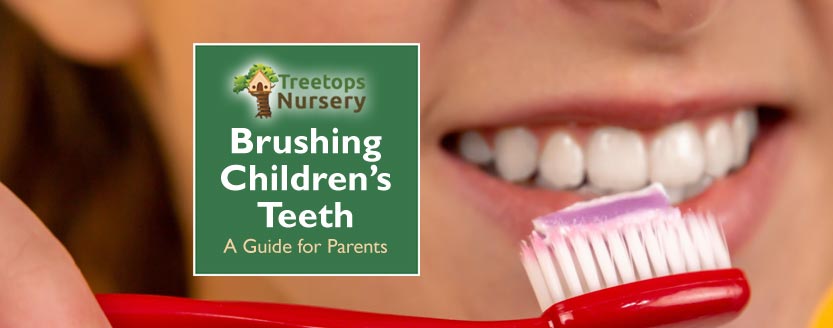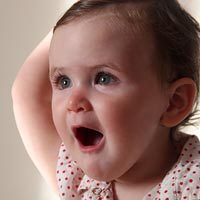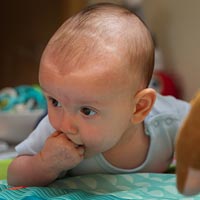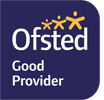
As promised in our Guide to Teething last month, this next guide is all about brushing teeth — specifically for for babies, toddlers and young children. Regular brushing of teeth is an essential habit for young children to get into. Doing so will protect their teeth and oral health as they grow older.
Studies suggest that brushing teeth twice a day, for at least 2 minutes, may even reduce the risk of poor heart health.
When Should You Start Brushing Children’s Teeth?
 Parents, guardians or carers should start brushing children’s teeth the moment teeth first appear, even when it’s only one or two teeth initially showing through. This is typically around the age of six to ten months when, for most babies, the lower incisors are first to appear. It varies enormously, though, with some babies even being born with one or more teeth. For teething babies, of course, you need to be more gentle with brushing than you would be for an older child, because their gums will probably be sore. Hence, there are some guidelines to follow in that regard. That’s exactly where this article comes in as we explain the accepted best practice for brushing infant teeth.
Parents, guardians or carers should start brushing children’s teeth the moment teeth first appear, even when it’s only one or two teeth initially showing through. This is typically around the age of six to ten months when, for most babies, the lower incisors are first to appear. It varies enormously, though, with some babies even being born with one or more teeth. For teething babies, of course, you need to be more gentle with brushing than you would be for an older child, because their gums will probably be sore. Hence, there are some guidelines to follow in that regard. That’s exactly where this article comes in as we explain the accepted best practice for brushing infant teeth.
How Much Toothpaste Should Babies, Toddlers & Children Use?
Check toothpaste labels carefully to ensure you are using the right toothpaste.
Toothpaste containing at least 1,000 parts per million (ppm) of fluoride or ‘family toothpaste’ containing 1,350 to 1,500ppm is suitable for babies and children up to 6 years of age.
- For babies and children up to 3 years old, use just a smear.
- For children between 3 and 6 years old, use a pea-sized amount on the brush.
Children 7 years old or more should also use a pea-sized amount, using toothpaste containing 1,350 to 1,500ppm of fluoride.
What’s the Best Way to Brush a Baby’s Teeth?
The NHS suggests that parents sit the baby on their lap, facing away from them towards a mirror (this is so that the child can learn from what the parent is showing them). The baby’s head can rest against you so that it’s kept stable during brushing.
Using the recommended toothpaste suggested in the section above, parents can apply just a smear of toothpaste to either a small tooth brush, finger brush or piece of clean gauze wrapped around a finger (whichever suits best). Then, this can be applied to the baby’s teeth using small, gentle, circular motions to both teeth and surrounding gums.
The baby will soon learn from watching this and will, in time, begin to try it themselves. The parent can help by guiding the child’s hand when this occurs.
As only a smear of toothpaste has been used, the baby does not need to spit it out and indeed, not rinsing will protect the teeth even further.
What About Teeth Brushing for Children Over 3?
 The same general approach can be used for children aged 3 or over, except toddlers may stand, so long as their head can still rest against you so that it’s kept stable and relatively still while brushing takes place. As mentioned in the preceding section, a pea-sized amount of toothpaste can be used for this age group.
The same general approach can be used for children aged 3 or over, except toddlers may stand, so long as their head can still rest against you so that it’s kept stable and relatively still while brushing takes place. As mentioned in the preceding section, a pea-sized amount of toothpaste can be used for this age group.
The child can spit out superfluous foam after brushing, but does not need to rinse. As before, this is because retaining a covering of fluoride will continue to protect the teeth for longer.
From the age of about 7, children will generally be capable of brushing their teeth themselves, unaided.
Tips to Protect Children’s Teeth from Decay
 As well as regular brushing of teeth and dentist check-ups, there are many additional measures that can protect children’s teeth. These really all come down to one thing; avoiding added sugar. So …
As well as regular brushing of teeth and dentist check-ups, there are many additional measures that can protect children’s teeth. These really all come down to one thing; avoiding added sugar. So …
- Check ingredients of what your baby or child is eating and drinking. Avoid anything that has added sugars, including baby foods.
- There are many kinds of sugar so check labels carefully. Sugar can come in many forms including raw, cane or brown sugar, glucose, dextrose, sucrose, maltose, fructose, molasses, hydrolysed starch, inverted sugar syrup and Muscovado sugar, to name just a few.
- Avoid sugary drinks. Young children should stick mainly to water or milk. While milk does contain an element of natural sugar, it’s less likely to cause harm to teeth than man-made or added sugars.
- If you give little ones fruit juice, dilute it. 10 part of water to 1 part of pure fruit juice is a good ratio.
- Limit fruit juice intake to 150ml per day maximum if you do not dilute it, making up the rest of their daily drink intake with milk and/or water.
- Children’s teeth should be brushed ideally immediately after eating or drinking anything sugary. This is to remove sugar and avoid build-up of plaque. In the case of fruit juice, brushing after drinking will remove acid found in the juice, as this can otherwise also harm teeth.
- Avoid giving children sweets and biscuits except, perhaps, for very occasional special treats. Otherwise they’ll get a ‘sweet tooth’ and it could become a habit, potentially harming their teeth and health.
- Consider sugar-free medicines if you do need to give your child medicine at any point.
- Free-flowing, open drinking vessels such as beakers are less likely to ‘bathe’ teeth in sugary drink compared to bottles or valved bottles, thereby reducing the possibility of tooth decay. Learn more about those in the ‘Health & Safety First’ section below.
When Should Children Start Going to the Dentist?
Children should regularly visit the dentist for check-ups, so it’s a good idea to start them early, so that it becomes a normal routine. Children need to appreciate that teeth brushing is important to teeth, oral hygiene and potentially to overall health. Visiting the dentist is recommended in case there is a problem of some kind and also to highlight whether teeth are being brushed optimally at home. If not, a good dentist will be able to point children and parents in the right direction.
It’s important for a dentist visit to be a pleasant, stress-free experience, so be sure to hide any anxiety you may have about dentists as a parent, otherwise this anxiety can be passed onto the child going forwards.
Health & Safety First!
 The more obvious additional health and safety concerns include the following:
The more obvious additional health and safety concerns include the following:
- For their own safety, babies and little ones need to be supervised at all times when brushing teeth.
- In the interests of safety, children must never be allowed to play with toothbrushes or toothpaste nor to run around with them (particularly in their mouths!).
- Do not allow babies or children to eat of swallow toothpaste, nor to lick the tube.
- Once babies start to phase out bottled milk (usually weaning off them from the age of around 6 months), bottles with ‘no-spill’ valves and spouted drinking cups and ‘sippy cups’ should be avoided, according to many dentists, orthodontists, speech therapists and healthcare professionals. This is to avoid a whole raft of potential problems including crooked teeth, tooth decay and potential speech issues.
“As oral health professionals at GOSH, we encourage children to move to an open cup as soon as possible to reduce the risk of dental [cavities] which are often connected to bottles or ‘sippy’ cups.” (Great Ormond Street Hospital for Children).
Clean Teeth for Healthy Kids
Keeping children’s teeth clean and free of plaque will help to keep teeth, gums and oral health in good shape. Starting early will also encourage kids to get into a good teeth cleaning habit from a young age and be more likely to carry that on into adulthood. Children with good teeth, healthy gums and fresher breath will generally feel more good about themselves, boosting self-confidence and self-image. Amazingly, recent studies even suggest that brushing teeth twice a day, for at least 2 minutes, may even reduce the risk of poor heart health.1
Our Nursery in Willesden, near Harlesden & Kensal Green
 This guide was brought to you by the childcare team at Treetops Nursery in Willesden, near Willesden Green, Kensal Green and Harlesden. If you’re looking for nurseries in those areas, around London NW10, we’d love to show you and your little one around so that you can see the setting in action for yourselves. To learn more about a possible place for your child, contact us using your preferred method below, while spaces are available:
This guide was brought to you by the childcare team at Treetops Nursery in Willesden, near Willesden Green, Kensal Green and Harlesden. If you’re looking for nurseries in those areas, around London NW10, we’d love to show you and your little one around so that you can see the setting in action for yourselves. To learn more about a possible place for your child, contact us using your preferred method below, while spaces are available:


 In this, the first of two new posts relating to the very youngest of children, we’re looking at teething, including when it usually happens and what to do about it as a parent or carer. Teething can be stressful for parents and a painful time for babies, so it’s important to read the signs correctly and act accordingly.
In this, the first of two new posts relating to the very youngest of children, we’re looking at teething, including when it usually happens and what to do about it as a parent or carer. Teething can be stressful for parents and a painful time for babies, so it’s important to read the signs correctly and act accordingly. Most babies are born with no teeth showing at all. However, there are exceptions and it’s reasonably common to be born with one or more milk teeth already visible. In total, babies will have a total of 20 milk teeth; 10 in the upper jaw and 10 in the lower. These are already there at birth as they will have grown during the embryonic stage. However, they are hidden within the gums in most cases.
Most babies are born with no teeth showing at all. However, there are exceptions and it’s reasonably common to be born with one or more milk teeth already visible. In total, babies will have a total of 20 milk teeth; 10 in the upper jaw and 10 in the lower. These are already there at birth as they will have grown during the embryonic stage. However, they are hidden within the gums in most cases. Teething can cause babies pain and discomfort during the 8 days in which each tooth moves from under the gum to erupting through it. Apart from the obvious signs of the tooth erupting and perhaps a bluey-grey eruption cyst colouration in the gums, symptoms of teething include:
Teething can cause babies pain and discomfort during the 8 days in which each tooth moves from under the gum to erupting through it. Apart from the obvious signs of the tooth erupting and perhaps a bluey-grey eruption cyst colouration in the gums, symptoms of teething include: There are a number of ways parents and carers can help babies and toddlers through their teething. One or more of the following may help:
There are a number of ways parents and carers can help babies and toddlers through their teething. One or more of the following may help: According to the NHS, there is no evidence that commercially-available teething gels (including homeopathic ones) are effective, so they recommend that non-medical options like those above should be tried first.
According to the NHS, there is no evidence that commercially-available teething gels (including homeopathic ones) are effective, so they recommend that non-medical options like those above should be tried first. When the time is right (usually by the age of 6) the milk teeth will start to shed. Normally, this is done in a particular order: first the two lower front teeth and the two upper front teeth will fall out (these are called the central incisors). Next to fall are the lateral incisors, then the first molars, the canines and finally the second molars.
When the time is right (usually by the age of 6) the milk teeth will start to shed. Normally, this is done in a particular order: first the two lower front teeth and the two upper front teeth will fall out (these are called the central incisors). Next to fall are the lateral incisors, then the first molars, the canines and finally the second molars.